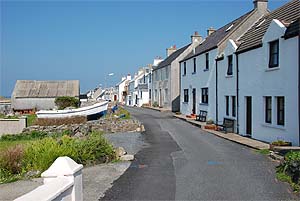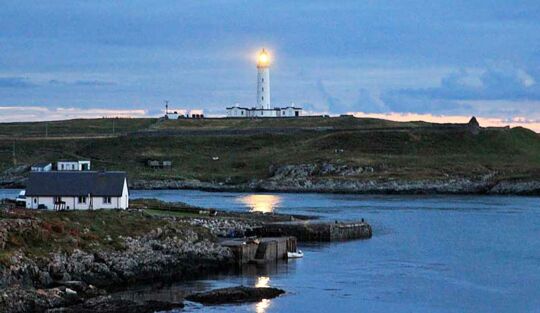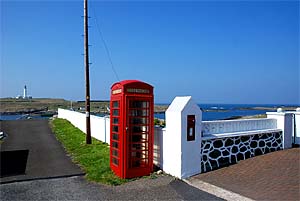Port Wemyss

Port Wemyss lies to the east of Portnahaven and offers beautiful views towards the Mull of Oa and Kintyre. With its beautiful white washed cottages, Port Wemyss is one of the island’s most picturesque villages.
The village and its close neighbour Portnahaven share a church, with separate entry doors. At one time, when the people of both villages were not so friendly to each other, this occasionally gave problems, such as with weddings when the Portnahaven people didn’t want to sit in the Port Wemyss side of the church and vice versa.
Port Wemyss History
Pronounced 'Port Weems', Port Wemyss was initially called Wemysshaven after the 8th Earl of Wemyss, father-in-law of Walter Frederick Campbell, laird of Islay. It was built in 1832 near the old village of Luib, which stretched from North Crescent (now Crom street) to near the Village Hall. The village was designed and built to clear the people from the land and encourage fishing.
There have always been close links between Islay and Ireland. The fish caught here were cured and traded in Ireland, from where most of the village’s goods came. Even today, many Ilich still travel to Ballycastle in August for the old Lammas Fair.
In October 1615 Sir James McDonald, Chief of Islay, made a final attempt to recover the ancient power of his family to no avail. English government troops and warships anchored in what is now Port Ellen.
The intended attack on Sir James was thwarted by beacons lit on the Mull of Oa, warning him in good time and allowing him to escape to Ireland. This was despite the pleas of 500 local Rinnsmen at the oars, from a rock 800 metres east from Port Wemyss, thereafter known as Slioc Ghulartidh (The Rock of Sorrows).
Rinns of Islay Lighthouse

Just offshore from Port Wemyss sits the island of Orsay and the Rinns of Islay lighthouse, both owned by the Northern Lighthouse Board. Standing 29 metres high, the lighthouse was designed and built in 1825 by the famous Scottish engineer Robert Stevenson.
Before automation in 1998 a principal lightkeeper and two assistants would perform four weeks’ duty at the station. They would travel to and from the island by helicopter from Oban, where there was a ‘shorestation’ for the keepers and their families. Before that, transfer of keepers, provisions and other light stores was by small boat.
Ràthas nan Lasgairean: The Path of the Fisherman
A beautiful coastal path, very well maintained by some of the locals, will help you get the most from Port Wemyss’s the lovely seaside. A plaque half way gives information about the coastal path and mentions that this project was possible due to generous donations by the local residents and friends of Port Wemyss.
The coastal path is called Ràthas nan Lasgairean, Gaelic for The Path of the Fisherman. It starts on the seaside on one end of the village and ends at the other. It’s not a long track but gives good opportunities to spot grey seals, otters and bottlenose dolphins swimming through the strong tidal currents.

Another interesting feature along the path is the old harbour, one of the nicest spots on Islay to watch sunsets and soak up the peaceful atmosphere. Just sit on the pier, enjoy the views and the fascinating strong tides, watch the curious seals, listen to the waves clashing gently against the rocks and the song of the seals on Orsay Island, and observe the various sea birds flying past.